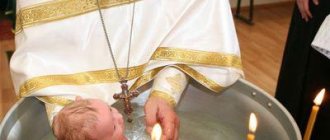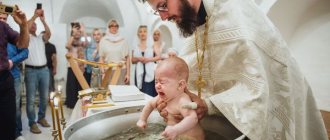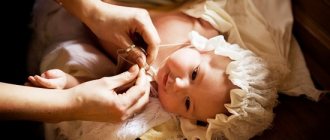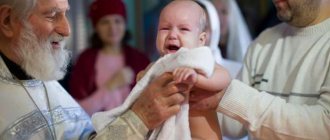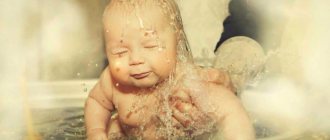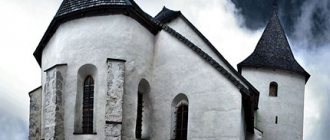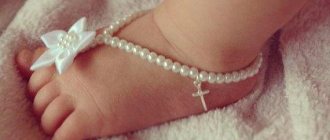Dear friends, my readers, my future clients! I would like to once again share my advice as a “baptism photographer” that will help you carefully prepare for the sacrament and get a predictable result in the form of the photographs you are waiting for.
The topic seems simple, and I have already written a lot about it: how to choose a temple, how to choose godparents, how to dress for the sacrament. All of these tips are fairly general. And I would like to talk about the little things and details that can absolutely affect the result of my work.
There is an opinion that filming the Sacrament of Baptism is reportage, it simply records life as it is. I don't agree. All photographers today take staged family photographs in the temple, which will become the most important components of the family archive, a family heirloom many years later. That’s why my customers prepare so carefully for this special day. And during shooting, “unexpectedly” moments appear that do not allow you to make the picture ideal.
Here's what I urge you to pay attention to:
Temple
- In a temple with white walls there will not be dark photographs, which many people like.
- In small churches there will be no general plans with a rich interior, photographs taken from above from the choir through the chandelier
- In the church, where renovations are underway, walls are being painted, there are scaffolding, in the baptismal - there will be mainly portraits and close-ups
- You can get the perfect picture in the form of a full-length ceremonial portrait with a beautiful light and shadow pattern only in a large temple with good light and in sunny weather
- Choosing the right day and time of baptism
- The choice of temple does not depend on all of the above. We choose with our heart and soul. And we will take beautiful photos
How to photograph a child's baptism.
I am not a clergyman, and therefore I cannot know all the intricacies of this or that sacrament, rite or ceremony, I don’t even really know what to call some of them correctly, but I know how to perform them. Therefore, let believers forgive me for incorrect expressions about what and how a clergyman does, or what happens during the baptism ceremony.
Photos from a child's baptism
We will omit the introductory word that in the traditions of the Orthodox Church the rite of baptism is a very important church sacrament that takes place only once in a person’s life, because everyone already knows about it, let’s get straight to the point.
Baptism in Vladimir Cathedral. Baptism is carried out not in the main part of the temple, but in the side 'Baptismal'
Typically, filming a baptism begins 15-20 minutes before the start of the ceremony in the temple. During these 15-20 minutes, I recommend photographing the baby in the stroller, in the arms of the parents, and taking group photos with the guests. It may happen that at the baptism ceremony the child bursts into tears so much that he will not be able to stop for a long time, and, alas, his makeup cannot be corrected, as a result, he will no longer be able to get normal pictures after the baptism. In any case, you need to take the camera out of the case on the street, before entering the temple.
If the shooting takes place in winter, then I recommend starting shooting directly from the temple, for one simple reason - so as not to freeze the equipment, which in the warm atmosphere of the temple will immediately begin to fog up and will have to be given 15-20 minutes to warm up. In this case, general photos with the temple should be taken after the ceremony, since when you take the equipment out into the cold street from a warm room, it will not fog up and will allow you to continue shooting, after which you will put the camera in the case and go home or leave by car to continue shooting (if it is planned, for example, at a baptism banquet). In any case, the camera will have time to settle, and you will not have to shoot during this time.
Baptism in the Church of the Life-Giving Spring (Kievo-Pechersk Lavra)
In different temples the ceremony itself may be carried out differently, but the difference itself is not particularly fundamental. Here I will explain how everything goes in an ordinary Orthodox church or temple. And everything goes according to the following plan:
1. The priest explains to the participants of the celebration how everything will go. A good priest will also tell a photographer where to go, where not to, where it’s best to stand, where it’s best to shoot - but this is rare. Usually no one explains anything to anyone, it gets to the point that on the set I have to help people at the ceremony understand what is happening and what needs to be done. For photographers who are photographing a baptism for the first time, I recommend asking the priest where and how you can move around the temple and warn that you are “a cool photographer with a DSLR that makes heartbreaking shutter clanks.” Believe me, all the clergy have long been accustomed to video and photography in their churches and it will not be difficult for them to advise you in two or three words. Those who especially wish can ask for blessings for filming, I asked for this a couple of times, but I didn’t hear anything other than “Yes, film,” and now I simply greet the clergyman and say that I will not disturb anyone.
The clergyman often holds the child in his arms
2. The child is given to the godfather in his arms, the godparents are placed “at attention” in a certain place, and the priest begins the ceremony. At this point I shoot 1-2 frames per minute, just letting everyone get used to the sound of the camera shutter.
Baptism of a child, Church of the Nativity in Obolon
3. The priest reads prayers over the cross, kryzhma (a special robe for a child that needs to be bought for baptism), font, etc. At this moment he can light candles over the font. Usually 3 candles are placed above the font. I love filming the moment the candles are lit over her. This is a good shot for adding to a photo book or album. Also, the priest also lights 2 candles for the godparents, which they hold during the entire baptism ceremony.
In fact, only one of the godparents holds both candles, while the second one tries to “cope” with the child.
Photos from a child's baptism
4. Father gives the godparents a piece of paper to read a.k.a. “Symbol of Faith”, usually the godmother holds a piece of paper from which she and the godfather read the necessary words. You can take 1-2 general shots, it will look like a kind of “oath”. At such moments, I photograph more of the child while he sits calmly in his godfather’s arms. By the way, there can be not one pair of godparents, but two, and even three! In such cases, they all stand together at the service before the priest, usually the priest forgets to transfer the child from one parent to another, as a result, one couple receives more photographs with the child than the other. To compensate for this injustice, be sure to take a group photo of only the godparents and the child when he is in the arms of different couples.
Photos from a child's baptism
5. The priest forces the godparents to renounce the devil. Oh yes, believe me, it's a sight to behold. To do this, he turns them towards the exit from the temple. Usually the photographer is somewhere on the priest’s side, and in the end it turns out that the godparents have their backs turned to him. In this case, I step a little to the side and take pictures of my parents and father as they stand in profile towards me. I don’t recommend going around and photographing parents from the front, because they need to “spit and blow on the devil,” and in the end they will spit and blow on the photographer. In addition, the priest himself can “blow” on the baby - this moment will fit perfectly into this report. After this, he again turns the godparents towards him and asks them to take an oath of union with God. By the way, in this case the godparents do everything for the child themselves, because the child is still small and cannot be responsible for himself. As a result, the godparents, instead of the child, renounce the devil and accept faith in God.
Baptism in Vladimir Cathedral, Kyiv
6. The father asks to undress the child. Usually the baby is taken to a special table and undressed there. This is a good reason to take pictures of a child naked, to photograph pleasant little things like mothers/fathers/grandmothers bending over him and trying to undress/dress him. Usually they strip down to diapers, but sometimes completely. Shoot as much as you like here.
Child Baptism
7. The priest anoints the child with oil (oil of joy). This is an important and responsible moment for the photographer. I recommend filming how the priest opens jars of oil, takes out a brush and anoints the baby (usually just the forehead). If the priest covered the child with himself, I advise you to raise the camera high up, set a wide viewing angle on the lens and take a couple of general shots from this sacrament. I usually take 2-3 pictures from this sacrament for a photo book.
Photo from a child's baptism. Anointing before immersion in the font
8. The most important point! The father takes the child in his arms and lowers him into the font. Although, he can ask his godfather to do this. Here you can film the baby in the priest’s arms as he walks from the godparents to the font. The result is vivid shots emphasizing the baptism - a child in the arms of the priest. Then the priest lowers the child into the font and pours holy water over him.
Child Baptism
Attention: it may happen that the priest, at the speed of light, will plunge the child into the font and take him back. I highly recommend shooting the first dip with burst shooting . Personally, I already know where each priest dips and how and I can adapt. But for those new to this business, I want to emphasize the fact that the font and dipping of the child is the key plot of the entire baptism ceremony . If you fail these shots, you will basically fail the entire baptism shoot. Usually at this time I take the maximum possible and necessary number of frames.
Baptism of a child in Pirogovo
It may be that the font is very small and the priest only lightly pours water on the child’s head. Here, too, you need to not make mistakes and shoot it beautifully. I use a flash and “freeze” falling drops of water with flash pulses, which looks very unusual and pleasant. I usually take this shot on the cover of a photo book.
Child baptism. Sample photos
9. The father soaks the sponge in water from the font and wipes the child with it. I almost never photograph this, because it is usually done very quickly and more symbolically. Although, often the priest puts his hand on the baby’s forehead and this can also make a good shot.
Photos from a child's baptism
10. The priest anoints the baby with myrrh, a procedure similar to anointing with oil, with the only difference that a person is anointed with myrrh once in his life and if you “mess up” this shot, it will be technically impossible to repeat it. But using the example of the sacrament of confirmation, you can quickly get your bearings and not miss anything. Usually the priest applies the oil to some parts of the baby’s body; at this moment you can remove it larger to show the process itself.
Photos from children's baptisms
11. After the font, the priest passes the child into the arms of the godparents, who at this time are holding the kryzhma. This “transmission” can also be removed. The father takes the scissors and cuts the baby's hair (more symbolically). This will also give you a good shot.
Baptism of a child in the Church of St. Nicholas the Wonderworker on the Waters
13. The priest leads the godparents around the lectern three times. You can shoot this moment from a wide angle. A 28mm focal length is enough for me when shooting with a full-format camera (the equivalent on a cropped camera is 18mm). Nothing special, and in a photo book it usually looks so-so.
Baptism of a child in the Holy Trinity Cathedral in Troieschyna (the baptismal sanctuary is located in the basement of the Temple)
13. After this comes the sacrament of “introducing” churching. The priest reads prayers over the child’s natural mother, then takes the child in his arms again and carries him to the icons. I strongly recommend taking a lot of shots with your own mother, because usually she is your customer, and it would be a sin not to take pictures of the child with his own mother.
Baptism of a child in the Holy Trinity Ionin Monastery
Attention! A very good shot can be caught at this moment. Usually the priest lifts the child up in his arms, which looks simply amazing. Don't miss this moment! The priest brings boys into the “Holy of Holies”, but does not bring girls there. At the same time, he enters some doors and leaves others. It is categorically forbidden to follow the priest through these doors!
Baptism in St. Andrew's Church
If possible, hold all the ceremony participants and ask them to take a group photo in the temple near the font. A couple of times they told me that you can’t photograph people who have their backs turned to icons. And in general, be prepared that you may hear such strange conclusions or requests that your digital camera may turn into a film one.
After leaving the temple, take another general photo of everyone present, take it wider so that the entire temple is visible. Such a photograph can be immediately placed in a photo book or album; it is final – the job is done, everyone is happy.
Baptism, St. Elias Church
Working with a videographer
Usually a baptism is filmed together with a videographer, who in 50% of cases is at a baptism for the first time :). I use a tactic where I am always behind the cameraman. This way he will never capture me in the frame. Believe me, it will be much easier for you to cut out the cameraman from a photograph than for him to remove you from the video. I recommend moving around the temple with a videographer strictly synchronously. Decide who sets the pace and point of shooting and adhere to this seniority. If the videographer is really “an oak tree,” film as you see fit. Personally, my team and I never observe any nuances or inconveniences when shooting videos and photos.
Sometimes a videographer will use an external light on their camera to highlight key details being filmed. Sometimes this light helps to shoot without flash. Below is a videographer filming with a Canon EOS 60D and a Canon Zoom Lens EF 24-70mm 1:2.8 L II USM using a monopod and an external light source mounted on the hot shoe of his DSLR camera.
Some videographers place additional light on special studio stands, and also use other equipment: external radio microphones (record sound from a certain point in the temple without extraneous sounds), tripods, monopods, rails and large body kits for their cameras. Particularly resourceful people place a small video camera in the font itself and film the baby’s dive with the view from the water.
Working in tandem with a videographer
Many people will probably be interested in the shooting technique. I use two different shooting techniques : with flash and without flash, which are radically different.
Without flash:
Without flash, I shoot at 90% using “M” mode with automatic ISO control turned on. This way I can control the shutter speed and aperture and the permissible ISO threshold at once. Not all cameras can use the auto-ISO function; with such cameras it is easier to use aperture priority mode. I take almost all pictures at shutter speeds from 1/50 to 1/125. A shutter speed of 1/125 is very convenient for photographing people; during this time, the frame does not blur from their movement in the frame. Usually my ISO threshold is 12,800 units. When shooting, I use spot metering and single-point focusing. In this state, exposure metering on my cameras is carried out over the area of the focus point, which allows me to get the subject I need correctly exposed. I always shoot in RAW, which makes it easy to correct small nuances. When shooting without flash, I try much more to duplicate the main frames, since due to long shutter speeds you can get blurry in some pictures.
With flash:
Of course, I would be happy to shoot without a flash all the time, but the picture with proper use of the flash is often much better than without it, this is due to the fact that most of the temples and churches in the middle are very, very dimly lit. The problem here is not the noise of the picture, but rather the fact that a child is usually baptized in the so-called baptismal room - a small and, accordingly, poorly lit room. In large temples, such a room is generally located in the basement of the temple. Sometimes there is nothing else except the light of a candle and a small lamp. When I shoot, I use high ISO settings (typically 640 to 3200) with flash to achieve the effect described here. Most often I shoot with a zoom lens, it’s just more convenient than carrying around a prime lens, and for reporting, the artistic component is sometimes not so important. Based on the feedback from my clients, I can say for sure that few people care at all about bokeh, volume and lens design when it comes to baptism.
To produce fewer light pulses, in the middle of the temple you can shoot in manual flash power control mode, and the flash will give only one pulse without trial firing. I shoot mainly with the Nikon system and can also use the aperture priority automatic mode without TTL, and the flash will fire automatically without using test pulses. Warn participants in the shooting that the flash is used with a diffuser and will in no way harm the child’s eyes. When shooting at high ISOs, the flash produces low-power flashes. The only serious drawback when working with flash is the glare from the interior of the temple. To combat glare, you just need to choose the right shooting location.
I recommend that you be sure to give some of the material in printed form. Even if you agreed that the end result will be digital photographs, print 2-3 of the juiciest photos in 20*30 format on glossy paper (it's not that expensive) and give it to the client and look at the expression on his face. Printed photography is something magical. Even when shooting on TFP or TFCD, I try to give away a couple of printed images. For baptisms I make small photo books, a photo book is a great thing, think about it.
When photographing a baptism, I do not sign a contract and very rarely meet with the client before filming. Usually a meeting is held only if the requirements for shooting are very high and the customer wants to see a printed version of the portfolio and more examples of photos than are shown on my website. When meeting or by phone/mail/chat, you should definitely agree on the start time of the ceremony and the location, the deadline for submitting the material, whether the book layout will be checked before printing, etc.
Many people still want to film the preparation of their child at home. I don’t like this, because the filming there is only for 5-10 minutes, and you have to go to the client’s home and hang around there for 1-2 hours. Moreover, for a photo book, you don’t want to mix shots in a house with shots in a temple or restaurant - baptism is an activity carried out exclusively in religious places and nowhere else. The child will still be undressed and dressed in the temple, at this moment you can just catch the necessary shots. Of course, if the client insists, we will rent both at home and in a restaurant (but for an additional fee  ).
).
It often happens that after baptism, the child and mother are taken home, and the whole cheerful company goes to some noisy establishment to celebrate, unnerving Rei. Moreover, the footage from the celebration may not be related to the baptism at all. Believe me, I've seen enough of this before! True, usually everything is more mundane, and guests who did not make it to the temple for the ceremony are waiting for people in the restaurant. You need to take general photos with these guests, capture the overall atmosphere of the room, after which you can take your leave and go home. I don’t recommend staying too long during the celebration in a restaurant; one hour is enough to photograph everything you need. Celebrations in a restaurant are usually held without a host (a.k.a. toastmaster or compere), so you will need to organize the “entire cheerful crowd” yourself. After finishing the shooting, I make sure to notify you about the time frame within which the photographs or book layout will be ready. Usually, as soon as the restaurant finds out that the photographer has done his job and is leaving, fuss and exclamations begin: “Take a photo of me with godfather Vasya,” you have to stay an extra few minutes and “finish all those suffering.”
Usually people ask that under no circumstances should you publish photos from a baptism anywhere, and one cannot but agree with them, so choosing something to publish on the site is extremely difficult.
Among the specific nuances of filming a baptism, I would like to note the fact that young children’s skin has a rather unusual shade, and there are a lot of spots. After shooting, you have to conjure for a very long time to create an acceptable “skin tone.” And what’s even worse is that the skin tone of newborns is not at all similar to that of an adult.
As a conclusion, I want to tell you that sometimes filming a baptism is very exhausting, the main reason for this is the crying of the child during the ceremony. In some churches, baptism is carried out for two or more couples at once. Listening to a whole choir of crying children for 30 minutes, which is how long a standard baptism ceremony lasts, is sometimes very, very difficult.
You can view the package of services that I offer for photographing a child’s baptism at the link https://www.wedding-photographer.tv/gallerys/photoset-04/krestiny-photo-price.html. Photo reports from the filming of the christening can be viewed on my blog here.
The material was prepared by Arkady Shapoval. Find me on Youtube | Facebook | | Instagram | Twitter | 500px.
Cloth
- The ideal clothing for a woman is a floor-length dress or skirt, plain ( not black ), closed-toe shoes. But this is optional. Sometimes a colored dress can give a completely artistic picture
- Ideal clothing for a man is classic trousers and a shirt (or suit), not shorts (even in the hottest weather), closed shoes (even in the heat)
- We can choose the color scheme of the clothes together. Sometimes it depends on the temple
- Ideal clothing for a child is a light, elegant, monochromatic set (dress) and a white christening shirt, if necessary, a transparent silicone pacifier/bottle, without ropes or colored chains
- If something is missing, wear discreet clothes and take beautiful photographs
Important points
In essence, filming a baptism is a reportage that is designed to capture the chronicle of events.
To know exactly what will happen in the church, it is better for the photographer to prepare in advance. This way you will understand what to expect and in which direction to point the camera so as not to miss important moments of the ceremony. When we talk about baptism, the story of immersing a baby in the baptismal font comes to mind. But this moment is not the only important one in the ritual. Everything needs to be recorded: the renunciation of Satan, the procedure of anointing with oil, putting the cross and white robes on the baby, anointing, walking around the baptismal font, washing off, and tonsure. It is known that during the sacrament, girls are brought to the royal doors, and boys are brought to the altar. It’s important to capture all this as clearly and beautifully as possible. It’s better if you find a favorable angle for each episode in advance and do several takes. Try to work delicately - the click of the camera shutter is very audible in the silence of the temple. He can prevent the priest from reading the prayer, and therefore you need to carefully choose the moment.
Types of baptism
Children are often baptized in groups, but it works better when baptisms are performed individually. Then, with a guarantee, there will be no “extra” people in the frame: other people’s children, guests, godparents, and the priest involuntarily “gets involved” in the shooting process, allowing the photographer to catch a good moment and even slightly improving it for the camera. If you still have to work with a group, you need to try to complete your task well. Be ready to quickly change the shooting point, keep “friends” and “strangers” in your field of vision at the same time.
However, benefits can be derived from such a situation. In a group baptism, all actions on children are performed one by one, so you can prepare. Using the example of another baby, understand what exactly will happen now and how best to film it. It is usually not very bright in a church - take a couple of test shots to determine the appropriate camera settings for the situation. Some priests do everything quickly, without slowing down for a second. Some carry out the ceremony in a measured manner - if “your” baby is not the first in the group, you can prepare to avoid surprises.
If you have to deal with a group baptism, then you don’t have to worry about the background.
Other couples and babies will create the right atmosphere in each frame. All babies behave differently at baptism. Filming one smiling while another is crying or sleeping can be very funny and touching.
A preliminary conversation with the baby’s godparents and parents will allow you to involve them in the filming process: agree with them on joint actions. Let them turn the baby towards the camera from time to time and gently but actively participate in the filming.
As practice shows, children, especially small ones, often cry during baptism. Usually, if the situation is not critical, the priest will not even interrupt the ceremony. But sometimes, in order to calm the child, you even have to involve the mother. Usually such moments come out very touchingly in the photo. But tell the adults not to grimace, but just smile at the baby. This is both more effective and prettier on camera.
Try to set the adults up correctly. The sacrament of baptism is a serious but joyful event. The more joyful, sincere smiles in the pictures, the more beautiful and positive the photographs will come out. After all, baptism is a celebration of a person’s second birth!
Related Posts
Video filming of the baptism in Cheboksary
23 May 2021 0
Baptism in the Church of the Holy New Martyrs and Confessors of Russia
15 Nov 2021 0
Baptism in Cheboksary
27 Jul 2021 0
Vanya's baptism
10 Sep 2015 0
Professional photographers for baptism
Choosing a photographer to photograph a child’s baptism is not an easy task, but on our website you can find an experienced professional from different cities of the Russian Federation, study a portfolio of completed works and choose the one you like.
If you know a good professional photographer who specializes in photographing baptisms, write to us, we will also recommend him to readers in this article.
A photographer from St. Petersburg with an impressive portfolio is Zoya Vanyukova.
Photographing Baptisms and Weddings is my main and favorite job. My task is to convey all the warmth and magic of this event, the sacrament of Baptism or Wedding. Reportage photography will not distract from an important event in your life. I will answer all questions. I will help you choose a church, advise you on how best to dress, etc. I will photograph the christening, make a touching slide show and a gorgeous photo book! Any questions you may have can be clarified by phone. 8-981-797-43-58. VK page https://vk.com/fotovanyukova, Instagram @zoya.vanyukova. Extensive experience in photography in cathedrals and churches of St. Petersburg. 8 years of experience. I also work in other cities (by agreement).
